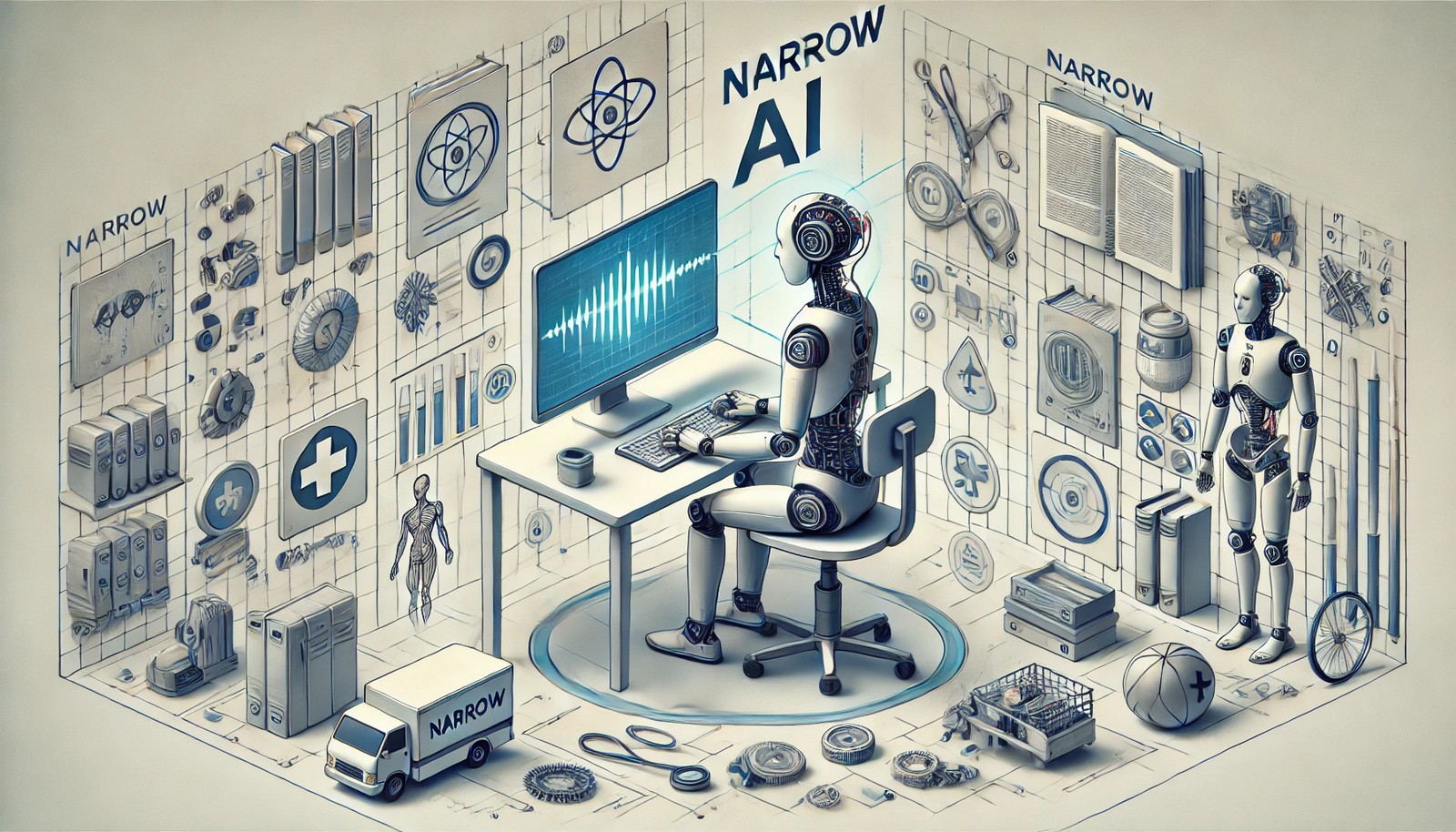Narrow AI

Quick Navigation:
- Narrow AI Definition
- Narrow AI Explained Easy
- Narrow AI Origin
- Narrow AI Etymology
- Narrow AI Usage Trends
- Narrow AI Usage
- Narrow AI Examples in Context
- Narrow AI FAQ
- Narrow AI Related Words
Narrow AI Definition
Narrow AI, also known as weak AI, is a type of artificial intelligence designed to accomplish a specific task. Unlike general AI, which aims to perform a wide range of tasks at a human intelligence level, Narrow AI is limited in scope, specializing in one area, such as facial recognition, language translation, or voice assistance. Technically, Narrow AI operates on algorithms and machine learning models fine-tuned for specific functions, making it effective in targeted applications without the cognitive flexibility of human intelligence.
Narrow AI Explained Easy
Imagine a robot that can only play one game, like chess. It’s excellent at chess but can’t do anything else—if you asked it to play a different game, like basketball, it wouldn’t know where to start! That’s what Narrow AI is: highly skilled at one thing but not flexible like humans, who can learn and do many things.
Narrow AI Origin
The concept of Narrow AI dates back to the early days of artificial intelligence research, where the focus was on creating specialized programs for specific tasks. Early examples include programs that solved math problems or played games. Over time, as technology advanced, Narrow AI became more sophisticated, leading to modern applications like search engines, virtual assistants, and autonomous systems with set parameters.
Narrow AI Etymology
The term "Narrow AI" originates from distinguishing artificial intelligence with a limited focus ("narrow") versus intelligence with the potential to mimic human versatility ("general AI").
Narrow AI Usage Trends
Narrow AI has grown increasingly prevalent with advancements in machine learning and data processing. In recent years, it has been integrated into industries like healthcare for diagnostics, finance for fraud detection, and retail for personalized recommendations. The trend leans toward greater specialization in AI, with applications becoming more precise and effective within narrow domains as data availability and processing power increase.
Narrow AI Usage
- Formal/Technical Tagging: Specialized AI, Weak AI, Task-specific AI
- Typical Collocations: Narrow AI applications, use of Narrow AI, limitations of Narrow AI, examples of Narrow AI
Narrow AI Examples in Context
“Narrow AI has transformed customer service with chatbots that assist customers in real-time with simple queries.”
“In healthcare, Narrow AI helps radiologists by highlighting potential areas of concern in imaging scans.”
“Voice assistants like Siri and Alexa are examples of Narrow AI because they perform specific tasks like setting alarms or answering questions.”
Narrow AI FAQ
- What is the difference between Narrow AI and General AI?
Narrow AI specializes in specific tasks, while General AI aims to perform a wide range of tasks with human-like intelligence. - Can Narrow AI learn new things on its own?
No, Narrow AI operates within a fixed set of parameters and cannot learn beyond its programmed capabilities. - Where is Narrow AI used?
Narrow AI is used in fields like customer service, healthcare, finance, and manufacturing. - Is Narrow AI dangerous?
Generally, Narrow AI poses minimal risk as it is limited to specific tasks and lacks self-awareness. - Can Narrow AI become General AI?
No, Narrow AI cannot evolve into General AI on its own as it is built with task-specific designs. - What are examples of Narrow AI?
Examples include virtual assistants, recommendation engines, and image recognition software. - Why is it called Narrow AI?
It’s called "Narrow" because its abilities are limited to a particular field or task. - How does Narrow AI work?
Narrow AI works by using algorithms and data to perform specialized tasks effectively. - What is the main advantage of Narrow AI?
The main advantage is its ability to excel at specific tasks, making processes more efficient. - How does Narrow AI impact daily life?
Narrow AI is embedded in many everyday technologies, from smartphones to search engines, enhancing convenience and accessibility.
Narrow AI Related Words
- Categories/Topics: Artificial Intelligence, Machine Learning, Automation
- Word Families: Narrow, Artificial, Intelligence, Specific, Specialized
Did you know?
Narrow AI, despite its limitations, has successfully outperformed human experts in specific fields, such as diagnosing certain diseases and detecting financial fraud. It’s impressive to consider how such focused AI systems are reshaping industries and influencing daily life without needing the full spectrum of human cognitive skills!
PicDictionary.com is an online dictionary in pictures. If you have questions or suggestions, please reach out to us on WhatsApp or Twitter.Authors | Arjun Vishnu | @ArjunAndVishnu

I am Vishnu. I like AI, Linux, Single Board Computers, and Cloud Computing. I create the web & video content, and I also write for popular websites.
My younger brother, Arjun handles image & video editing. Together, we run a YouTube Channel that's focused on reviewing gadgets and explaining technology.



Comments powered by CComment